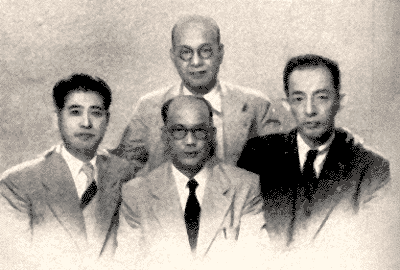
S. A. Ayer
Encyclopedia

Publicity
Publicity is the deliberate attempt to manage the public's perception of a subject. The subjects of publicity include people , goods and services, organizations of all kinds, and works of art or entertainment.From a marketing perspective, publicity is one component of promotion which is one...
and Propaganda
Propaganda
Propaganda is a form of communication that is aimed at influencing the attitude of a community toward some cause or position so as to benefit oneself or one's group....
in Subhas Chandra Bose's Azad Hind Government between 1943 and 1945, and later a key defence witness during the first of the INA trials
INA trials
The INA trials or the Red Fort Trials refer to the courts martial of a number of officers of the Indian National Army between November 1945 and May 1946 variously for treason, torture, murder and abetment to murder....
.
Ayer had travelled to Bangkok
Bangkok
Bangkok is the capital and largest urban area city in Thailand. It is known in Thai as Krung Thep Maha Nakhon or simply Krung Thep , meaning "city of angels." The full name of Bangkok is Krung Thep Mahanakhon Amon Rattanakosin Mahintharayutthaya Mahadilok Phop Noppharat Ratchathani Burirom...
in November 1940 as a Special correspondent for Reuters
Reuters
Reuters is a news agency headquartered in New York City. Until 2008 the Reuters news agency formed part of a British independent company, Reuters Group plc, which was also a provider of financial market data...
before joining the Indian Independence League
Indian Independence League
The Indian Independence League was a political organisation operated from the 1920s to the 1940s to organize those living outside of India into seeking the removal of British colonial rule over India...
. In October 1943, Ayer was appointed the Minister of publicity and propaganda in the nascent Azad Hind Government.
Following the successful Allied Burma Campaign
Burma Campaign
The Burma Campaign in the South-East Asian Theatre of World War II was fought primarily between British Commonwealth, Chinese and United States forces against the forces of the Empire of Japan, Thailand, and the Indian National Army. British Commonwealth land forces were drawn primarily from...
and the fall of Rangoon, Ayer left with the city with the rest of the cabinet, and was destined for Tokyo
Tokyo
, ; officially , is one of the 47 prefectures of Japan. Tokyo is the capital of Japan, the center of the Greater Tokyo Area, and the largest metropolitan area of Japan. It is the seat of the Japanese government and the Imperial Palace, and the home of the Japanese Imperial Family...
at the time of the alleged death of Subhas Chandra Bose. At the time of the Surrender of Japan
Surrender of Japan
The surrender of Japan in 1945 brought hostilities of World War II to a close. By the end of July 1945, the Imperial Japanese Navy was incapable of conducting operations and an Allied invasion of Japan was imminent...
, Ayer was in Tokyo
Tokyo
, ; officially , is one of the 47 prefectures of Japan. Tokyo is the capital of Japan, the center of the Greater Tokyo Area, and the largest metropolitan area of Japan. It is the seat of the Japanese government and the Imperial Palace, and the home of the Japanese Imperial Family...
from where he was repatriated to India
India
India , officially the Republic of India , is a country in South Asia. It is the seventh-largest country by geographical area, the second-most populous country with over 1.2 billion people, and the most populous democracy in the world...
to give evidence in the Red Fort trials and became a key defence witness in the first trial. In 1951, Ayer published his personal accounts of the Indian National Army
Indian National Army
The Indian National Army or Azad Hind Fauj was an armed force formed by Indian nationalists in 1942 in Southeast Asia during World War II. The aim of the army was to overthrow the British Raj in colonial India, with Japanese assistance...
and Subhas Chandra Bose called "Unto Him a Witness: The Story of Netaji Subhas Chandra Bose in East Asia, Bombay, 1951".

